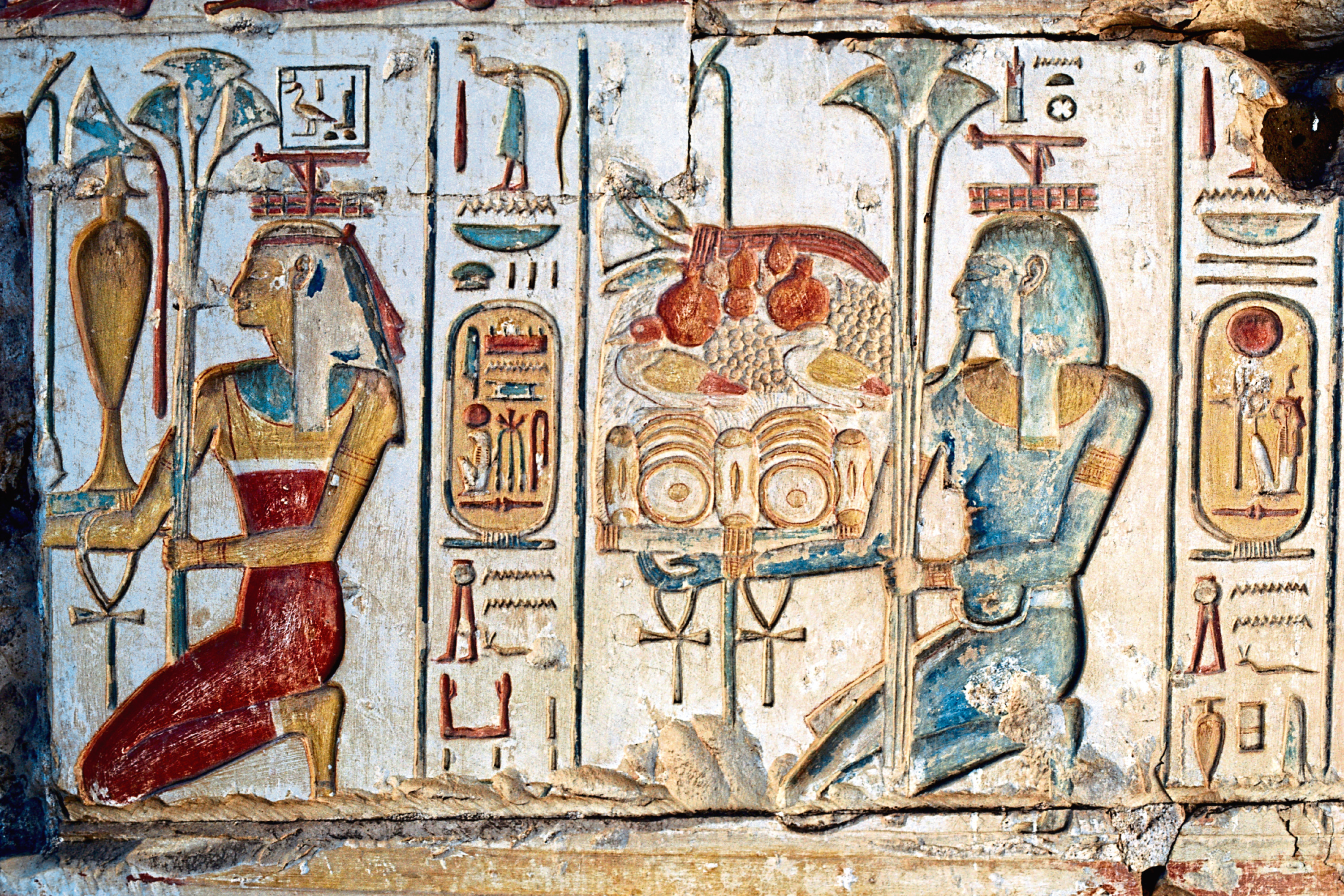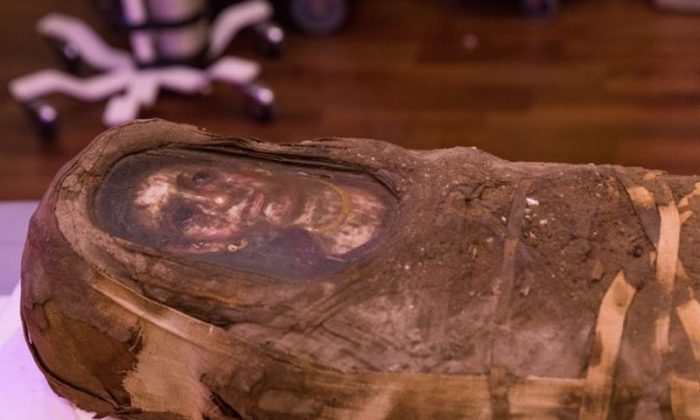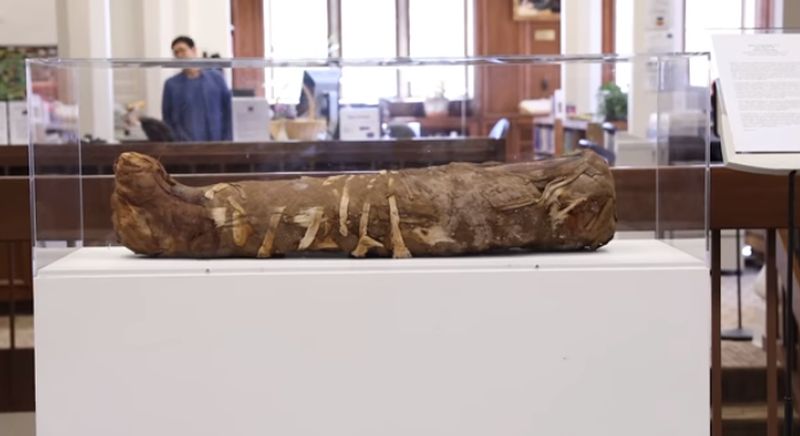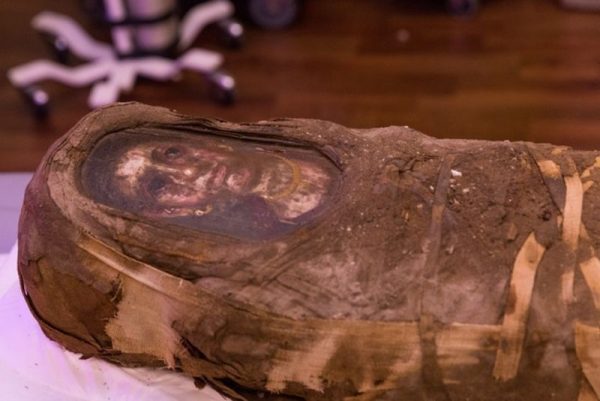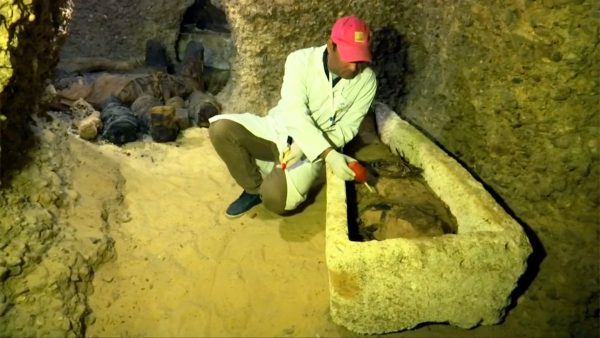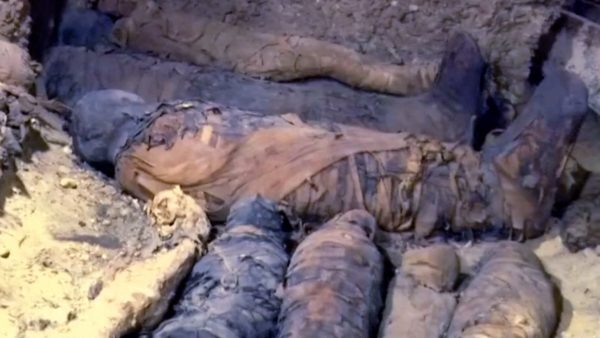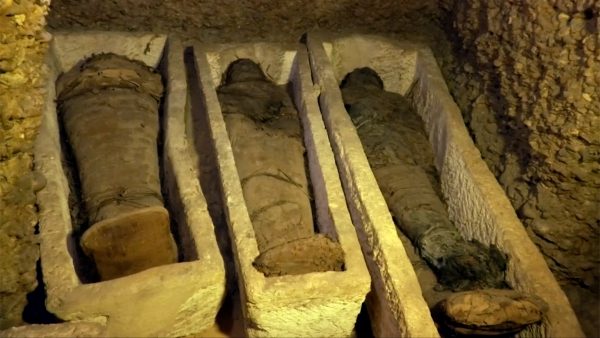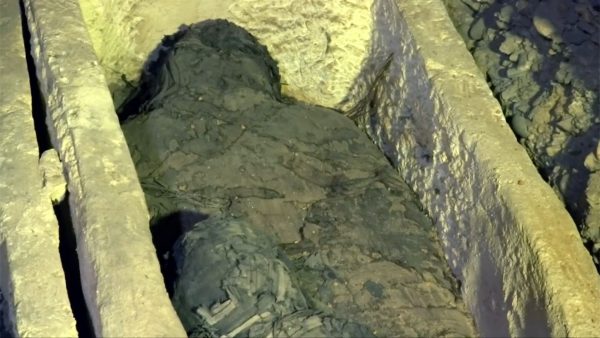https://www.osirisnet.net/news/n_02_19.htm?en
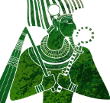



Newsletter Osirisnet Février - February 2019
Plus de quarante momies viennent d'être trouvées à Touna el-Gebel More than 40 ancient mummies from Ptolemaic period found at Tuna el-Gebel
Photos: Egypt Ministry of Antiquities

Voici l'annonce exceptionnelle évoquée dans la newsletter du mois dernier : une quarantaine de momies d'époque ptolémaïque ont été découvertes sur le site de Touna el-Gebel, qui se trouve en Moyenne Égypte, près de la ville de Minya. Elles ont plus de 2 000 ans, mais sont "en bon état de conservation".
Parmi ces momies, "douze sont celles d'enfants, six celles d'animaux (chiens surtout) et le reste celles d'hommes et de femmes adultes.
Pour voir ces momies, il faut descendre en bas d'un puits étroit, de neuf mètres de profondeur. Il débouche sur vaste salle dans laquelle s'ouvrent de nombreuses petites chambres funéraires qui contiennent les corps brunâtres. Certaines momies ont été placées dans des sarcophages en pierre ou en bois, tandis que d'autres ont été enterrées dans le sable ou posées à même le sol ou dans des niches. Les corps sont bandelettés, avec parfois des inscriptions en démotique. Quelques fragments de cartonnage provenant des masques mortuaires recouvrant les épaules et la tête, ou les pieds, sont parfois présents. Des ostraca (tessons de poteries ou éclats de calcaire) et des fragments de papyrus ont également été découverts sur place.
Il s'agirait d'une tombe collective, appartenant à une famille de "l'élite de la classe moyenne".

Here is the exceptional announcement mentioned in last month's newsletter: in "a maze of tombs", about forty mummies from the Ptolemaic period have been discovered on the site of Tuna el-Gebel, which is located in Middle Egypt, near the city of Minya.
Among these mummies, "twelve are those of children, six those of animals (especially dogs) and the others those of adult men and women".

To see these mummies, you have to go down a narrow well, nine metres deep. It leads to a vast room in which many small funeral chambers open, containing brownish bodies.
It is a familial grave, which belongs to "a family from the elite middle class". The grave consists of a number of burial chambers inside which lay some forty human mummies of different genders and age, including children. All are in a good conservation condition. The mummies are wrapped in linen, and sometimes bear Demotic inscriptions. Mummies of men and women still bear fragments of the colorful cartonnage (a material made of linen or papyri and covered in plaster) that once covered their heads and feet.
The methods used in burying the mummies inside this maze of tombs varied. Some of them were buried inside stone or wooden sarcophagi while others were buried in sand or laid on the floors or inside niches.
Ostraca and fragments of papyri were also found in the tomb, he said, which helped reveal that it could date to the Ptolemaic, early Roman and Byzantine periods.
Un atelier de sculpture datant du Nouvel Empire trouvé au Gebel el-SilsilaNew Kingdom workshop uncovered in Gebel el-Silsila
Photos: Gebel el-Silsila Project

La mission suédoise de l'Université de Lund dirigée par le Dr Maria Nilsson et John Ward, a découvert un atelier de sculpture monumentale sur grès sur le site archéologique de Gebel el-Silsila. La mission a trouvé, au fond d'un puits profond comblé par les débris des époques postérieures, les restes d'un atelier de sculpture avec l'ébauche d'un grand criosphinx (sphinx à tête de bélier) mesurant environ 5 m de long, 3,5 m de haut et 1,5 m de large. Le contexte archéologique suggère une datation de l'époque d'Amenhotep III. Le nouveau sphinx est le troisième trouvé sur le site, qui a par ailleurs fourni la plus grande partie du grès utilisé dans les temples et monuments de l'Égypte ancienne.
Le sphinx nouvellement découvert comporte un autre sphinx plus petit au niveau de son ventre ; cette petite chose était peut-être une statue d'entraînement taillée par un apprenti. À proximité, un sculpteur a entrepris de tailler dans la paroi l'uræus destiné à ceindre la tête du plus grand des criosphinx mais la pièce est restée à l'état d'ébauche grossière.
Par ailleurs, des centaines de fragments inscrits de hiéroglyphiques appartenant à un naos détruit, également de l'époque d'Amenhotep III, ont aussi été découverts, ainsi que des morceaux d'un obélisque, y compris sa pointe.
On ignore pourquoi le grand sphinx et les autres pièces n'ont pas été achevés. Peut-être le décès du souverain a-t-il entraîné l'arrêt du travail ou les ouvriers ont-ils repéré une fissure dans la roche. Plus tard, les débris issus de l'activité des carrières romaines ont enterré les sphinx dans les décombres.

The Swedish mission from Lund University led by Dr. Maria Nilsson and John Ward, has discovered a New Kingdom sandstone workshop and several sculptures during excavations carried out at Gebel el-Silsila archaeological site. The mission unearthed a large criosphinx (ram-headed sphinx) measuring approximately 5 m long, 3.5 m high, and 1.5 m wide from a deep pit of quarry debris dumped there during the Roman era.
The evidence suggests that the sphinx was carved around the end of the reign of pharaoh Amenhotep III.
The new sphinx is the third one found at the site, which was the source of much of the sandstone used in Ancient Egyptian temples and monuments.
The newly unearthed sphinx was found with a smaller sphinx sculpture nestled along its belly; that small sculpture may have been a practice statue carved by an apprentice. Both sculptures are rough-cut and prepared for transportation, but were likely abandoned at Gebel el-Silsila as the larger sculpture fractured. Centuries later, Roman quarry activity buried the sphinxes in spoil. Nearby the practice piece, a rough-cut uraeus was also uncovered; it was made to crown the head of the larger criosphinx.
Hundreds of fragments inscribed in hieroglyphs that belong to a destroyed naos of Amenhotep III, were also discovered. In addition, parts of an obelisk, including its pyramidion, were retrieved.
Ce qu'on trouve sous les maisons pas loin des pyramides Egypt police finds ancient burial site while investigating illegal dig at house near Pyramids
Photos: Egypt Ministry of Antiquities

Un habitant du district de Nazlet el-Samman, proche des grandes Pyramides de Guiza, a creusé illégalement sous sa maison à la recherche d'antiquités. Il a ainsi pratiqué deux excavations, une mesurant 1,5 m de profondeur, et l'autre 4 m de profondeur. Une des excavations mène dans un corridor qui débouche dans une pièce de 2,5 X 2 m. Il s'y trouvait une fausse porte et un puits creusé dans le rocher.
L'autre excavation mène à une pièce dans laquelle on trouve deux triades de statues debout, taillées directement dans le rocher. Elles ont subi des mutilations volontaires au niveau de la tête et des jambes.
Le développement incontrôlé des constructions ces dernières années (en particulier après le printemps arabe de 2011) a permis à la ville du Caire de se rapprocher de la zone archéologique de Guiza, ce qui apparaît clairement lorsqu'on parcourt le Plateau. Le danger pour ce site majeur est immense.

Everything is in the title!
A resident of Nazlet el-Samman district near the Pyramids of Giza, had illegally dug under his house looking for ancient artefacts. One of the excavations was 1.5 metres deep and the second 4 metres deep. Within one excavated area, a corridor led to a rock-hewn 2 metres by 2.5 metres room. Inside the room was a false door, and a well carved into the rock.
In the other excavation, a room housing six wall-relief statues was discovered. Some of the statues had smashed heads and legs.
Le squelette d'une jeune fille entourée de deux crânes de bovins à MeidoumSkeleton of a teenage girl found at Meidum, alongside two bull skulls
Photos: Egypt Ministry of Antiquities

Des archéologues égyptiens travaillant sur le site de la pyramide de Meidum, sous la direction d'Omar Zaki, ont fait une étrange découverte dans un mastaba jouxtant la pyramide. Il s'agit de la tombe d'une jeune fille dans laquelle se trouvaient deux crânes de bovidés. La fillette avait environ 13 ans; elle reposait en position foetale et ses ossements étaient tassés dans une petite fosse. Les deux crânes, ainsi que trois vases en céramique constituaient les seules - et bien curieuses - offrandes. On ignore les causes du décès de l'enfant, mais on peut le dater d'environ 4600 av. J.C., époque à laquelle Houni, dernier roi de la IIIe dynastie commença la construction de la pyramide, qui sera poursuivie par le premier roi de la IVe dynastie, Snéfrou.

An Egyptian archaeological mission directed by Omar Zaki, is working in the area of Meidum pyramid, east of Al-Mastaba No. 17. It came across a strange tomb, with the skeletal remains of a 13-year-old girl huddled inside, a squatting position. The team also found two bull skulls and three ceramic vessels nearby that were likely placed as funerary offerings. While the sex and approximative age have been determined, much about the burial and the offerings are still unclear. How or when did the young girl die is a mystery, though the experts say the site itself dates back to the end of the Third Dynasty roughly 4,600 years ago, as it is thought that the construction on the Meidum pyramid began at the command of the Third Dynasty's last pharaoh, Huni, and was continued by Snefru, the first pharaoh of the Fourth Dynasty.
Un atelier de construction navale et de réparation dans le SinaïAncient workshop for construction of boats uncovered in Sinai
Photos: Egypt Ministry of Antiquities

Les fouilles effectuées par une mission égyptienne sur le site archéologique de Tel Abu Seify, situé à 3 km à l'est du canal de Suez, dans le nord du Sinaï, ont mis au jour les vestiges d'un bâtiment en calcaire qui était autrefois un chantier naval, destiné à la construction et la réparation des bateaux pendant la période ptolémaïque et romaine. Le site aurait été l'emplacement de la forteresse romaine de Silla. Le chantier naval dispose de deux cales sèches pour la construction et l'entretien des navires, séparées par un bâtiment rectangulaire. Le plus grand dock est à l'est et ses murs d'enceinte ont une largeur de 6 m. Les deux murs s'étendent vers le sud en direction du lac antique sur environ 25 mètres de long. Lorsque le lac et la branche du Nil qui l'alimentait, se sont asséchés, la plupart des gros blocs de calcaire ont été retirés de leur emplacement d'origine pour être réutilisés ailleurs.

Excavations carried out by an Egyptian mission at the Tel Abu Seify archaeological site, located 3km to the east of Suez Canal in Northern Sinai, uncovered the remains of a limestone building that was once a workshop for the construction and repair of boats and vessels during the Ptolemaic and Roman periods. The site is said to have been the location of the Roman fortress of Silla. The shipyard contains two dry docks to build and maintain ships, with a rectangular building between them. The bigger dock is to the east and its surrounding walls are 6 m wide. Both walls extend to the south towards the old lake for about 25 meters long. Most of the large limestone blocks were taken out of their original place to be reused at later time after the port was no longer in use when the lake and the Nile branch dried out.
Serge Sauneron, The Priests of Ancient Egypt

La traduction anglaise de l'ouvrage incontournable de Serge Sauneron "Les prêtres de l'Égypte ancienne" est téléchargeable gratuitement au format pdf sur le site Internet Archive... mais pas la version française. Heureusement vous pouvez vous la procurer en livre à un prix dérisoire (j'ai même vu une offre à 0,90€ sur Priceminister)
We seldom report about downloadable books in pdf, but we warmly recommand this one to the English speaking readers. It's the English translation of a famous French book by the great Egyptologist Serge Sauneron, who died too young on an Egyptian road.
Nouvelle publication

À l'occasion de la grande exposition "Toutankhamon - Le trésor du Pharaon !", qui se tiendra à Paris du 23 mars au 15 septembre 2019, Florence Quentin vient de publier "Dans l'intimité de Toutankhamon. Ce que révèlent les objets de son trésor" aux éditions First (16,95 €). Florence Quentin, diplômée d'histoire de l'art, d'égyptologie et journaliste, est connue notamment grâce à la publication il y a quatre ans du "Livre des Égyptes", dont elle avait la direction.
L'ouvrage dont nous parlons ici est résolument tourné vers le grand public, et intéressera même ceux qui n'ont pas de connaissances particulières en égyptologie. L'auteur s'en explique clairement dans un avertissement :
À chaque début - et parfois en fin - de chapitre, j'ai fait le choix de "fictionner" certains épisodes de la vie du jeune roi afin d'incarner par touches ce que fut son existence, d'humaniser les objets luxueux de sa tombe en les replaçant dans leur décor d'origine. Et ainsi, je l'espère, de mieux représenter le passé. De l'éclairer sous un autre angle. Les lacunes dans nos connaissances sont donc ici comblées par l'imagination qui, "mise au service de la raison, est la faculté essentielle qui permet de représenter et de penser l'histoire" (Rémi Besson). Pour autant, ces récits liminaires romancés ne sont pas sans fondement et s'appuient sur des éléments provenant de sources fiables.
Quant aux épisodes qui ont trait à la découverte et aux fouilles de la KV622, ils sont inspirés directement des récits d'Howard Carter et des membres de son équipe ou encore, de documents ultérieurs montrant par exemple que l' archéologue britannique avait déjà pénétré dans la tombe avant son ouverture officielle.
Il en résulte un livre de 300 pages, agréable à lire. S'il ne saurait être classé parmi les ouvrages universitaires, il permettra de préparer de manière vivante une visite à l'exposition.
-- Sent from my Linux system.







